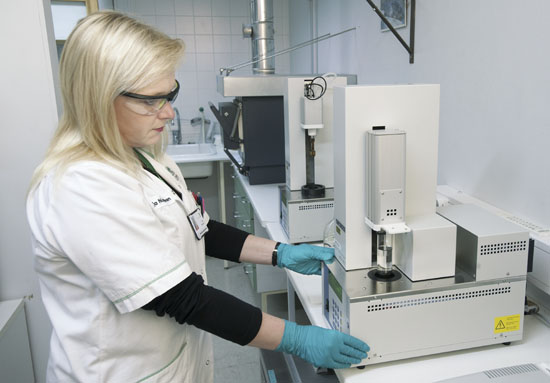Right now the forest industry is experiencing a hectic period of fostering new products and business models, with a focus on biofuels and the development of new, wood-based materials.
Wood construction is also undergoing a renaissance at the moment. Sustainability and climate issues form the common denominator for all new-era wood products.
Finland is engaged in large investment projects with the EU regarding the utilisation of biomass. The country holds a leading position internationally in the research of bioenergy, biofuels and biorefineries. The Finnish forest cluster aims to double the value of forest products and services by 2030, based on 2006 levels.
Bioenergy already makes up an important portion of today’s forest business. About 20 percent of Finland’s energy is generated from wood, while Finland’s forest industry produces 70 percent of the county’s renewable energy. The simplest sources of bioenergy include felling residue such as branches, treetops and small-diameter trees. However, by-products from the wood-processing industry form the main part of bioenergy.
Biofuels to replace fossil fuels

In the lab in Lappeenranta: UPM’s new refinery in eastern Finland will turn oil from pinewood into biodiesel. Photo: Ari Nakari/UPM
The newest dimensions of bioenergy are biofuels – gas, petrol and diesel. UPM is building a large refinery in the eastern Finnish city of Lappeenranta. It will use crude tall oil from pinewood as its raw material, annually producing some 100,000 tonnes of biodiesel for vehicles. Construction commenced in the summer of 2012 and operations begin in 2014.
Metsä Group’s unit Metsä Fibre in the nearby village of Joutseno is already making biogas by gasifying wood chips and refining them into biogas, a product whose composition resembles natural gas. Finnish energy company Fortum will build a bio-oil facility, integrated with their power plant in the eastern Finnish city of Joensuu, aimed at supplying fuel for cargo vessels. The new bioenergy company Green Fuel Nordic finishes two new bioenergy plants in Savonlinna and Iisalmi, also in eastern Finland, in 2013. They both start operations as power plants and will expand production to wood-based biofuels.
Composites and other new innovations

Supportive environment: Onbone’s medical casts are made from woodchips and biodegradable plastic. Photo: Onbone
New forest industry products include microfibrils, nanocellulose, formable plywood, thermoformable paperboard and biocomposites.
Microfibrils are obtained from cellulose or wood pulp. The fibrils enable durable, light, wood-based material that, like plastic, can be shaped. It can be used for multiple purposes in paper, hardboard, furniture, automobiles, electronics, food, pharmaceutical, cosmetic and construction products. The fibrils can replace materials such as plastic, certain chemicals and aluminium. For instance a wrapping film made of nanofibrilled cellulose can be used in food packaging instead of plastic to keep products fresh.
Composites are combinations of two or several different materials, for example wood and plastic. Woodcast, manufactured by Onbone, is a medical cast made from wood chips and biodegradable plastic. Wood-based casting plaster represents the biggest innovation in the field since the 1970s. Composites can be used also in products as diverse as furniture and car parts, and can also be made of recycled materials that utilise wood-derived fibres extracted from paper. Many of the composites are easily formable into different shapes. They have also proved to be strong and moisture resistant.
Printed intelligence – electronics that can be rapidly and cheaply outputted by a printing machine – forms an innovation that is already in widespread use. Stora Enso has developed an application especially for pharmaceutical packages, combining the product info with the patient’s medical information.
NFC (near field communication) is based on a close-proximity radio-frequency identification technique and used in smartphones, toys and games. It allows information sharing between different components and objects. UPM and its cooperation partners have already opened 12 online stores utilising this innovation.
Wood construction boom

Wood is being utilised on a completely new scale in both apartment houses and public buildings. Photo: UPM
Since the Second World War, the major house construction materials in Europe have been stone and concrete. In recent years, environmental awareness has increased the attention given to building materials. At the EU level, it has become clear that building with wood is significantly more environmental friendly than using concrete. So the aim is to reduce concrete construction and increase the use of wood whenever possible.
This trend opens new markets for Finnish sawmill products, wood and house-construction elements. House packages, in which customers select from various floorplans and a house is constructed using preassembled elements, have been well established for years, and quantities seem set to increase further in the coming decades.
In Finland and all over Scandinavia, fire safety regulations have been revised in recent years, allowing wood to be utilised on a completely new scale in both apartment houses and public buildings.
Activating the potential of wood construction on a European scale would have a great effect on reducing climate change. In Finland some 40 percent of new buildings are made of wood. In Europe as a whole, wood represents only about 4 percent of construction.
With new technologies and methods developing continuously, the possibilities and uses for wood and wood products are unlimited, and will keep the wheels of the Finnish forest industry rolling into the future.
By Vesa Kytöoja, March 2013





